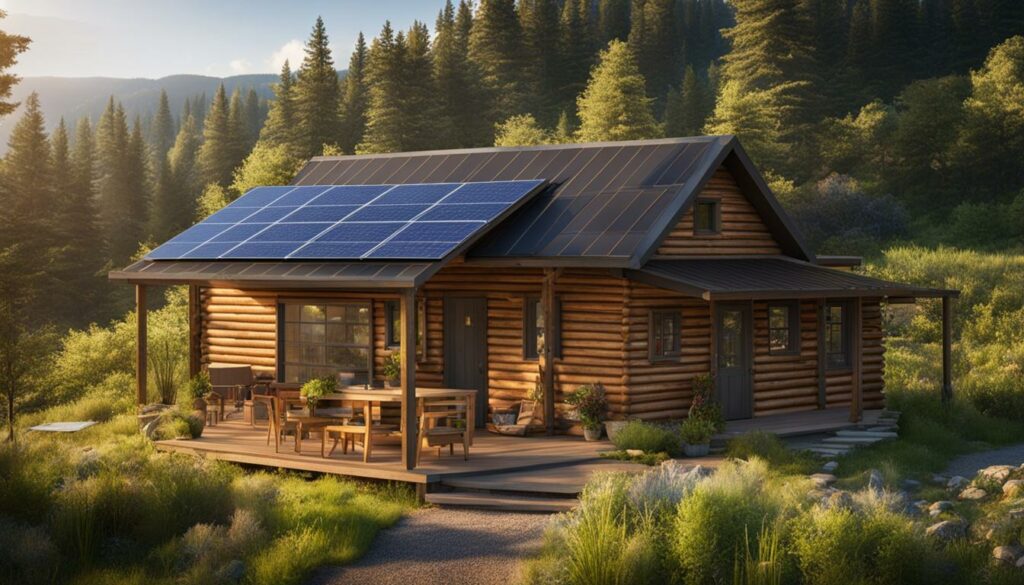Living off the grid presents a special chance to adopt a sustainable and independent way of life. It allows people to escape from the limitations of conventional living and explore a greener and unconventional lifestyle. By embracing off-grid living, individuals can decrease their environmental impact, attain energy autonomy, and enjoy the pleasures of self-sufficient living. This article acts as your complete manual for embracing the off-grid lifestyle, furnishing you with valuable perspectives and practical advice to assist you in navigating this thrilling journey.
Key Takeaways:
- Off-grid living allows individuals to live a sustainable and self-sufficient lifestyle.
- By embracing off-grid living, you can reduce your ecological footprint and minimize your impact on the environment.
- Off-grid living offers the opportunity to achieve energy independence through renewable energy sources.
- Homesteading and green living practices are integral to off-grid living.
- Embracing an off-grid lifestyle requires careful planning, preparation, and understanding of local regulations.
Discovering Different Off-Grid Lifestyles
Off-grid living encompasses various lifestyles, each with its unique characteristics and requirements. When considering the transition to off-grid living, it’s essential to explore the different options available and choose the right off-grid lifestyle that aligns with your needs and preferences. Here are some popular off-grid lifestyles to consider:
Tiny House Living
Living in a tiny house has gained popularity among those seeking a minimalist lifestyle. These compact homes often range from 100 to 400 square feet, with a focus on maximizing space efficiency. Tiny house living promotes simplicity, sustainability, and reduced environmental impact. It allows individuals to live comfortably while minimizing their carbon footprint.
Houseboating
If you gravitate toward a life on the water, houseboating is an excellent off-grid lifestyle choice. Houseboats provide the freedom to explore different bodies of water and enjoy a unique living experience. With solar power or low-consumption generators, houseboats can be self-sufficient, allowing you to embrace off-grid living while surrounded by nature’s beauty.
Living in Nature
For those who seek a deeper connection with nature, living off-grid in a remote location can be a fulfilling choice. This lifestyle involves living off the land, growing your own food, and relying on renewable energy sources like solar or wind power. It offers a sense of self-sufficiency and tranquility, as you immerse yourself in the serenity of nature.
When choosing the right off-grid lifestyle, consider factors such as location, personal preferences, and the level of self-sufficiency you desire. Each off-grid lifestyle has its own advantages and challenges, so it’s crucial to assess your needs and make an informed decision that aligns with your goals and values.

| Lifestyle | Characteristics | Advantages |
|---|---|---|
| Tiny House Living | Compact and efficient homes | Minimalist lifestyle, reduced environmental impact |
| Houseboating | Living on water, mobility | Close connection with nature, self-sufficiency |
| Living in Nature | Remote locations, self-sustainability | Deep connection with nature, tranquility |
Getting Rid of Unnecessary Belongings
Before embarking on the exciting journey of off-grid living, it is crucial to declutter and get rid of unnecessary belongings. Minimalism plays a significant role in this lifestyle, as it allows individuals to simplify their lives and create a more organized and efficient living space. By reducing belongings, you can focus on what truly matters and embrace the freedom that comes with off-grid living.
Decluttering is not just about getting rid of physical items; it also involves letting go of emotional attachments and the need for material possessions. It is a process that requires reflection and a shift in mindset. By letting go of excess baggage, you create space for new experiences and opportunities.
Here are some practical tips to help you declutter and reduce your belongings:
- Start small: Begin with one room or area at a time to avoid feeling overwhelmed. Set achievable goals and gradually work through your living space.
- Sort and categorize: Create separate piles for items you want to keep, donate, sell, or discard. This helps you make conscious decisions about what is truly essential.
- Consider the 80/20 rule: The Pareto Principle states that we use 20% of our belongings 80% of the time. Assess each item and ask yourself if it falls within the crucial 20%.
- Be mindful of sentimental items: While sentimental items hold emotional value, it is essential to evaluate their practicality and whether they enhance your off-grid lifestyle.
- Adopt a “one in, one out” policy: When bringing in new items, commit to removing an equivalent item to maintain a clutter-free living space.
By decluttering and embracing minimalism, you create a space that reflects your values and priorities. It allows you to focus on what truly matters and enjoy the freedom of off-grid living.
Financing Your Off-Grid Lifestyle
Embarking on an off-grid lifestyle may require financial planning and resources. By exploring various financing options, you can ensure that your dreams of sustainable living become a reality. Here are some financing options to consider:
- Savings: Use your existing savings to fund your off-grid lifestyle. This option provides immediate access to funds and allows you to start your journey without incurring debt.
- Loans: Apply for loans from financial institutions that specialize in sustainable and eco-friendly initiatives. These institutions may offer competitive interest rates and flexible repayment terms.
- Crowdfunding: Explore crowdfunding platforms to raise funds for your off-grid lifestyle. Present your project to a community of like-minded individuals who may be interested in supporting your journey.
It’s important to assess your financial situation and choose the financing option that best suits your needs. Remember to consider factors such as interest rates, repayment terms, and the impact on your overall financial stability. With careful planning and budgeting, you can secure the necessary funds to embrace off-grid living.
Table: Comparison of Financing Options for Off-Grid Living
| Financing Option | Pros | Cons |
|---|---|---|
| Savings | Immediate access to funds No debt incurred |
May deplete existing savings Limited amount available |
| Loans | Flexible repayment terms Competitive interest rates |
Potential debt accumulation Eligibility criteria |
| Crowdfunding | Potential for community support No repayment required |
Not guaranteed funding Time-consuming campaign creation |
Remember, financing your off-grid lifestyle is just one aspect of your journey. It’s equally important to focus on building self-sufficiency and embracing a sustainable lifestyle once you’ve secured the necessary funds. By combining financial planning with practical skills, you can create a fulfilling and rewarding off-grid experience.

Reducing Food Expenses and Cooking Time
Off-grid living offers the opportunity to embrace a sustainable and self-sufficient lifestyle, and one aspect of this lifestyle is the ability to reduce food expenses and cooking time. By making smart choices and incorporating pantry staples into your diet, you can enjoy delicious meals while saving money and time in meal preparation.
Table: Pantry Staples for Off-Grid Living
| Item | Description | Benefits |
|---|---|---|
| Rice | A versatile grain that can be used as a base for various dishes. | Cost-effective and provides long-lasting energy. |
| Beans | A rich source of protein and fiber. | Budget-friendly and adds bulk to meals. |
| Canned Goods | Includes items like canned vegetables, fruits, and soups. | Convenient, long shelf life, and adds variety to meals. |
| Dried Herbs and Spices | A flavorful addition to any dish. | Enhances taste, reduces the need for salt, and adds variety to meals. |
| Root Vegetables | Includes options like potatoes, carrots, and onions. | Long-lasting, versatile, and provides essential nutrients. |
Additionally, meal planning and batch cooking can significantly reduce food expenses and cooking time. By planning your meals in advance, you can make efficient use of ingredients, reduce food waste, and save money. Batch cooking involves preparing large quantities of meals and freezing them in individual portions for future consumption. This method saves time and allows you to have ready-made meals when you’re occupied with other off-grid activities.
By incorporating these pantry staples into your diet and adopting meal planning and batch cooking strategies, you can enjoy delicious and nutritious meals while minimizing your food expenses and cooking time in your off-grid lifestyle.
Lowering Bills and Preparing for Off-Grid Life
Lowering bills and preparing for off-grid life is a crucial step in embracing a sustainable and self-sufficient lifestyle. By reducing expenses and adopting energy-efficient habits, individuals can minimize their reliance on external resources and fully immerse themselves in the off-grid experience. Here are some practical tips to help you lower your bills and prepare for the rewarding journey of off-grid living:
1. Embrace Energy Efficiency
One of the key aspects of reducing bills in off-grid living is embracing energy efficiency. Consider investing in energy-efficient appliances, such as LED bulbs, low-flow showerheads, and smart power strips. These upgrades can significantly decrease your energy consumption and lower your utility bills. Additionally, prioritize insulation and weatherization to minimize heat loss in your off-grid home, allowing you to rely less on heating and cooling systems.
2. Implement Water-Saving Techniques
Water usage is another significant expense to consider when preparing for off-grid life. Implementing water-saving techniques can help lower your water bills and reduce your reliance on external water sources. Install low-flow fixtures, collect rainwater for irrigation, and consider composting toilets to reduce your water consumption. By embracing these practices, you can become more self-sufficient and minimize your environmental impact.
3. Create a Budget and Track Expenses
Creating a budget is essential for managing your finances and preparing for off-grid living. Start by analyzing your current expenses and identifying areas where you can make cuts. Set realistic goals and allocate funds for essential off-grid supplies, such as solar panels or water filtration systems. As you transition into off-grid living, track your expenses to ensure you stay within your budget and make adjustments if necessary.

Remember, off-grid living requires careful planning and preparation. By implementing these tips, you can lower your bills and ensure a smooth transition to a self-reliant lifestyle. Embrace energy efficiency, implement water-saving techniques, and create a budget to achieve financial stability in your off-grid journey. With the right strategies in place, you can enjoy the rewards of off-grid living while minimizing your impact on the environment.
Choosing the Right Off-Grid Home
When embarking on an off-grid lifestyle, one of the most important decisions is choosing the right home. Off-grid homes come in various forms, each with its advantages and disadvantages. Understanding these options is essential to create a comfortable and sustainable living environment. Let’s explore the different types of off-grid homes and what they have to offer.
Types of Off-Grid Homes
1. Tiny Houses: These compact and energy-efficient homes are popular among off-grid enthusiasts. They minimize environmental impact and provide a cozy living space. However, limited square footage may pose challenges if you require more room for a growing family or specific activities.
2. Earthships: Earthships are environmentally friendly and self-sufficient homes that typically utilize recycled materials and renewable energy sources. They offer a unique architectural design and a high level of sustainability. However, constructing an earthship can be a complex and time-consuming process.
3. Cabin in the Woods: For those seeking a rustic off-grid experience, a cabin in the woods might be the perfect choice. These homes are typically located in remote areas surrounded by nature, providing tranquility and a close connection to the outdoors. However, their isolation may present challenges in terms of access to amenities and services.
Advantages and Disadvantages
| Off-Grid Home Type | Advantages | Disadvantages |
|---|---|---|
| Tiny Houses | – Energy-efficient | – Limited space |
| Earthships | – High sustainability | – Complex construction |
| Cabin in the Woods | – Connection to nature | – Limited access to amenities |
These are just a few examples of off-grid homes available to aspiring off-gridders. The right choice ultimately depends on your preferences, needs, and resources. It is essential to carefully consider the advantages and disadvantages of each option to find the perfect off-grid home that aligns with your goals and lifestyle.

By selecting an off-grid home that meets your requirements, you can create a sustainable and self-sufficient living space. Whether you opt for a tiny house, an earthship, or a cabin in the woods, embracing off-grid living offers the opportunity to live in harmony with nature while minimizing your ecological footprint. So, take the time to research and explore the various off-grid home options available to find the perfect fit for your off-grid journey.
Powering Your Off-Grid Home
Powering an off-grid home is a key consideration for those embracing the off-grid lifestyle. By harnessing renewable energy sources, individuals can achieve energy independence and reduce their environmental impact. There are several options available for powering an off-grid home, including solar power, wind power, and hydroelectric power.
Solar Power
Solar power is one of the most popular and easily accessible sources of renewable energy for off-grid homes. By installing solar panels on the roof or in the surrounding area, homeowners can capture sunlight and convert it into electricity. This clean and abundant energy source not only powers the home but also charges batteries for nighttime or cloudy days. With advancements in technology, solar power systems have become more efficient and affordable, making them an excellent choice for off-grid living.
Wind Power
Wind power is another viable option for powering off-grid homes, especially in areas with consistent wind patterns. Installing a wind turbine allows homeowners to harness the power of the wind and convert it into electrical energy. Similar to solar power, wind power systems can store excess energy in batteries for use during periods of low wind or high energy demand. It is important to consider factors such as average wind speed and local regulations before installing a wind turbine.
Hydroelectric Power
For off-grid homes located near a water source such as a river or stream, hydroelectric power can be an excellent choice. This involves harnessing the kinetic energy of moving water and converting it into electricity through a turbine or generator. Hydroelectric power systems can provide a consistent and reliable source of energy, especially in areas with abundant water resources. However, it is important to assess the feasibility and potential environmental impact before implementing hydroelectric power.
When choosing a renewable energy source for an off-grid home, it is essential to consider factors such as location, climate, and energy requirements. Each option has its advantages and considerations, and it is recommended to consult with professionals and conduct thorough research before making a decision. By carefully selecting and implementing a renewable energy system, individuals can power their off-grid homes sustainably and enjoy the benefits of self-sufficiency.
Zoning Laws and Building Codes for Off-Grid Living
Off-grid living is an exciting and rewarding lifestyle choice, but it is important to understand the zoning laws and building codes that govern it. These regulations vary by location and can have a significant impact on the feasibility and legality of your off-grid living plans. By familiarizing yourself with the local requirements and complying with them, you can ensure a smooth and hassle-free off-grid experience.
Zoning laws dictate how land can be used and the types of structures that are allowed in a particular area. It is essential to research and understand the zoning regulations in your desired location before purchasing land or building an off-grid home. Some areas may have specific zoning designations for off-grid dwellings, while others may require special permits or variances. By adhering to these laws, you can avoid legal complications and ensure that your off-grid lifestyle is in compliance with local regulations.
| Location | Zoning Laws | Building Codes |
|---|---|---|
| Rural Area | Allows off-grid living with minimal restrictions. | May not require building permits for certain structures. |
| Urban Area | May have stricter regulations on building size and appearance. | Requires building permits for any construction. |
| Suburban Area | May have a mix of zoning designations, depending on the specific neighborhood. | Requires building permits and compliance with building codes. |
Building codes, on the other hand, establish standards for construction safety and quality. They cover various aspects of building design and construction, including structural integrity, electrical systems, plumbing, and insulation. It is crucial to ensure that your off-grid home complies with these codes to safeguard your safety and the well-being of your community. Failure to meet building code requirements can result in fines, forced modifications, or even the demolition of your structure.
Before embarking on your off-grid journey, it is recommended to consult with local authorities, architects, or professionals familiar with zoning laws and building codes in your area. They can provide valuable guidance and help you navigate the legal considerations associated with off-grid living. By understanding and complying with these regulations, you can enjoy the benefits of off-grid living while staying within the bounds of the law.

Key Points:
- Off-grid living is subject to zoning laws and building codes that vary by location.
- Understanding and complying with these regulations is crucial for a smooth off-grid living experience.
- Zoning laws govern land use and may have specific designations for off-grid dwellings.
- Building codes establish standards for construction safety and quality.
- Consulting with local authorities and professionals can provide guidance on legal considerations and compliance.
Permits for Off-Grid Construction and Land Use
When it comes to embarking on an off-grid lifestyle, obtaining the necessary permits for construction and land use is a crucial step. These permits ensure that your off-grid projects comply with local regulations and help foster positive relationships with regulatory authorities. This section will guide you through the process of securing permits and highlight their importance in your off-grid journey.
Construction Permits
Before starting any construction on your off-grid property, it’s essential to obtain the required construction permits. These permits ensure that your building plans meet safety and structural standards set by the local authorities. To secure a construction permit, you will typically need to submit detailed building plans, including architectural designs and structural calculations, to the local building department. This ensures that your off-grid construction adheres to the necessary standards and regulations.
Land Use Permits
In addition to construction permits, you may also need to obtain land use permits for your off-grid property. These permits regulate how the land can be used and may vary depending on the location and zoning regulations. Land use permits typically involve demonstrating that your off-grid plans align with the designated land use regulations. It’s important to consult with local planning authorities to determine the specific requirements and obtain the necessary permits before proceeding with your off-grid project.
| Permit Type | Description |
|---|---|
| Construction Permit | Ensures compliance with safety and structural standards for off-grid construction. |
| Land Use Permit | Regulates how the land can be used and ensures off-grid plans align with zoning regulations. |
Summary
Securing permits for off-grid construction and land use is crucial for ensuring compliance with local regulations and building safe, sustainable structures. Construction permits ensure that your building plans meet safety standards, while land use permits regulate how the land can be used. By obtaining the necessary permits, you can navigate the legal aspects of your off-grid lifestyle and embark on a successful and sustainable journey.
Conclusion
Off-grid living offers individuals the opportunity to embrace a sustainable and self-sufficient lifestyle. By following the comprehensive guide provided in this article, individuals can experience freedom, sustainability, and happiness while minimizing their impact on the environment.
From discovering different off-grid lifestyles to financing options and reducing expenses, this guide has covered various aspects of off-grid living. It has provided valuable insights into off-grid home selection, powering methods, legal considerations, and permits. By embracing off-grid living, individuals can enjoy the benefits of a sustainable lifestyle and contribute to a greener future.
Living off-grid may require adjustments and preparation, but it is a life-changing decision that can lead to a fulfilling and rewarding journey. The joys of self-sufficiency, renewable energy, and a closer connection with nature are just some of the many benefits of off-grid living. So, what are you waiting for? Take the first step towards off-grid living today and unlock a world of sustainable possibilities.
FAQ
What is off-grid living?
Off-grid living refers to a lifestyle where individuals or households are self-sufficient and not dependent on public utilities such as electricity, water, or gas. They generate their own power through renewable energy sources and acquire water from wells, rainwater harvesting, or other means.
Why choose off-grid living?
Off-grid living offers freedom, sustainability, and self-sufficiency. It allows individuals to reduce their impact on the environment, decrease expenses, and live a simpler, more fulfilling life close to nature.
How can I finance my off-grid lifestyle?
Financing options for off-grid living include utilizing personal savings, obtaining loans from financial institutions, or even crowdfunding. It is important to explore the various options and find the best fit for your financial situation.
What are some ways to reduce food expenses while living off-grid?
To decrease food costs, consider stocking up on pantry staples such as grains, legumes, canned goods, and dried fruits and vegetables. These items have a long shelf life and can be used to create affordable and nutritious meals.
How can I lower bills and prepare for off-grid life?
Lowering bills and preparing for off-grid life can be achieved by adopting energy-efficient habits, such as using LED lights, insulating your home, and reducing water consumption. It is also essential to educate yourself about sustainable living practices and make necessary adjustments before transitioning to off-grid living.
What are the different types of off-grid homes?
Off-grid homes come in various forms, including tiny houses, houseboats, earthships, and cabins. Each type has its advantages and disadvantages, and it is important to choose one that aligns with your lifestyle and preferences.
How can I power my off-grid home?
Off-grid homes can be powered with renewable energy sources such as solar power, wind power, or hydroelectric power. Installing solar panels or wind turbines can provide a reliable source of electricity for daily needs.
What zoning laws and building codes are important for off-grid living?
Zoning laws and building codes for off-grid living can vary by location. It is crucial to understand and comply with these regulations, which may cover aspects such as land use, building permits, and waste disposal.
What permits do I need for off-grid construction and land use?
Off-grid construction and land use may require permits such as construction permits and land use permits. It is important to research and obtain the necessary permits to ensure compliance with local regulations.



















